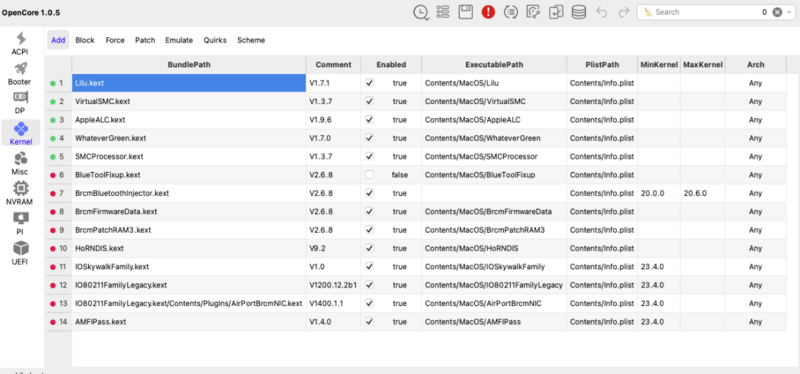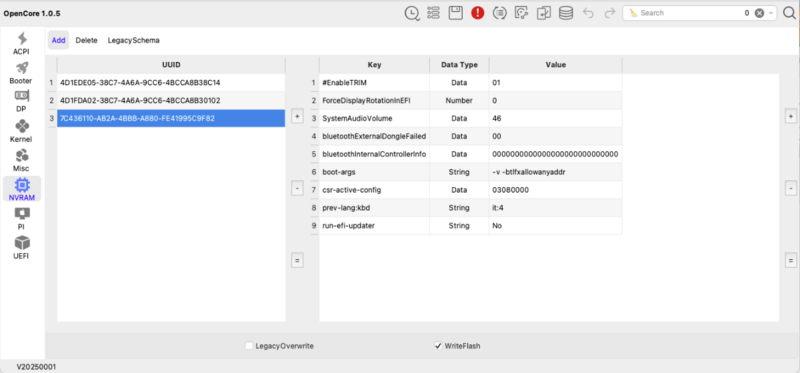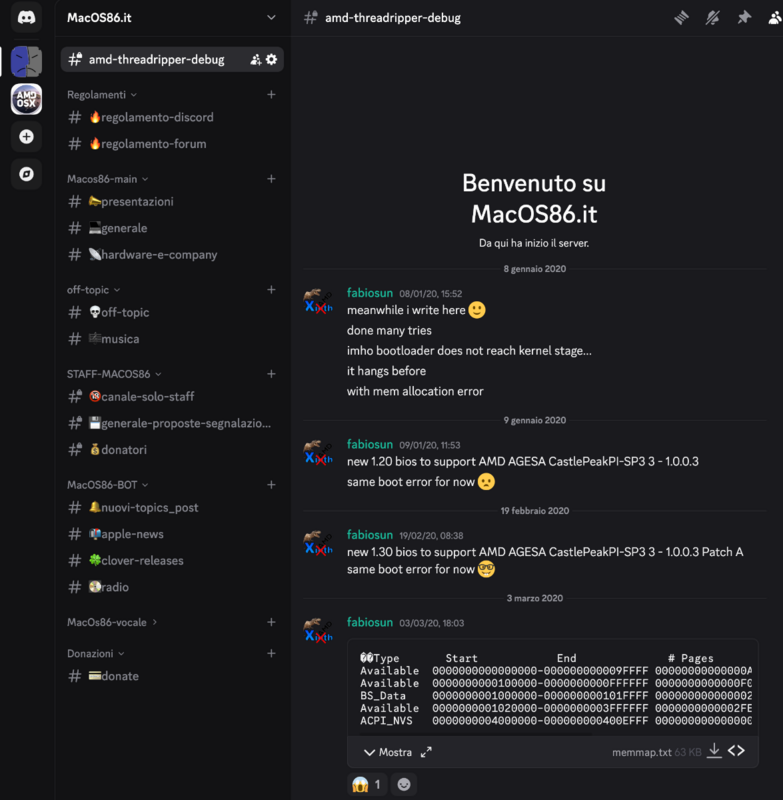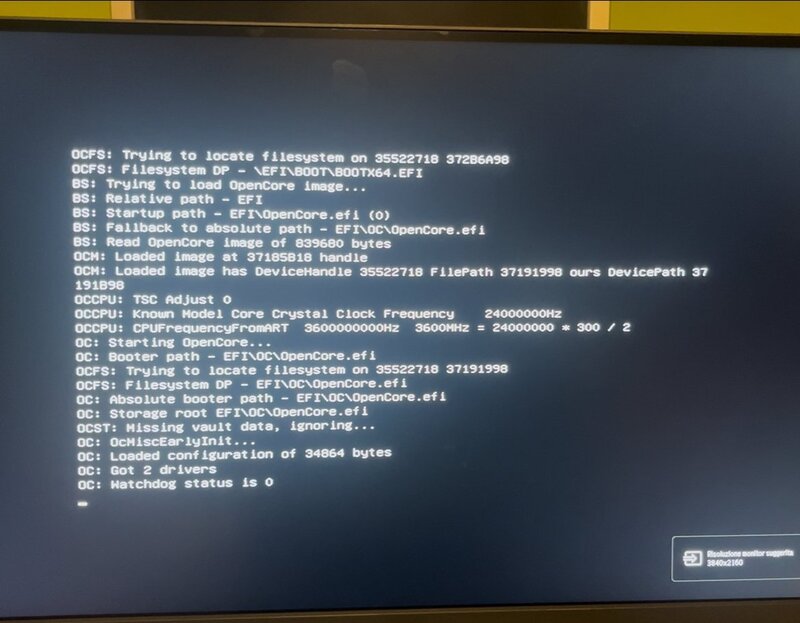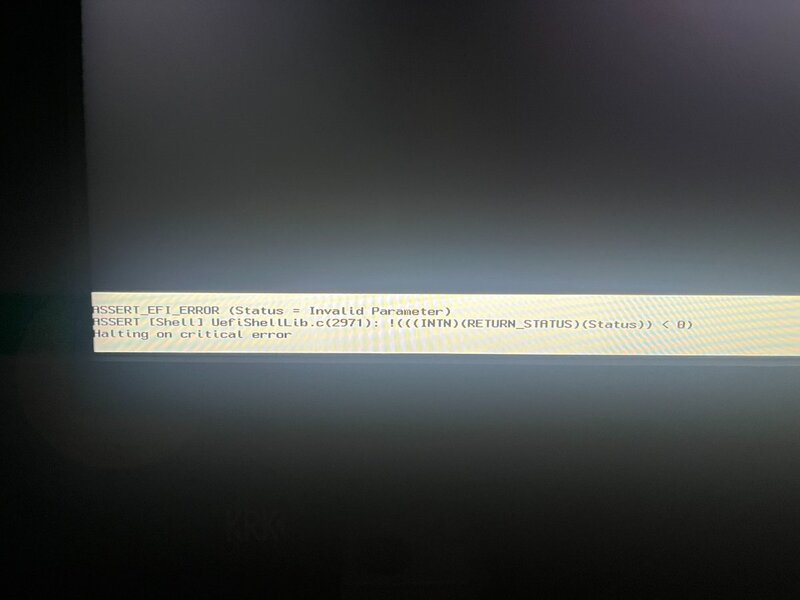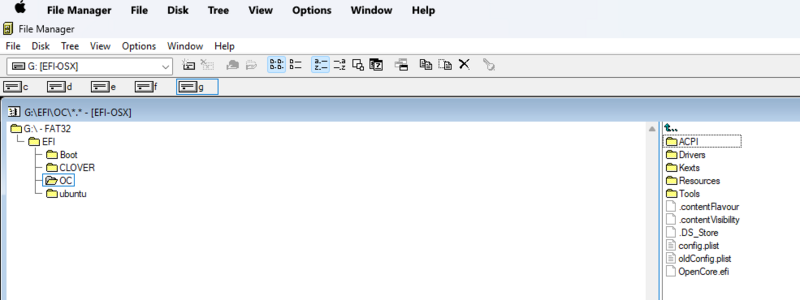All Activity
- Past hour
-
ciao Perdu, se usa alcuni sistemi come bootchooeser puo' far partire qualsiasi config in parti diverse e nome diverso. Sono fuori dal pc ora , poi do una occhiata se non chiarisce prima lui 🙂
-
buonasera @fabiosun ma non li ha neanche dichiarati nel config.sys ma in oclp-config.plist dentro OC da li non penso li peschi anche se li carica e non li dichiara nel config.sys chiedo venia se se ho detto una cosa errata controlla la EFI postata da lui
-
forse non li ha caricati perche' troppo pesante la cartella EFI?
-
@dany Guarda dove hai i tuoi file, sono li dentro ma mancano i Kext EFI\OC\oclp-config.plist perché stanno qui non lo so, quel .plist non dovrebbe neanche starci li non ci fa niente, chiedo conferma ad @Anto65 e @fabiosun per non spararla grossa almeno loro ci fanno le lezioni ogni volta insieme a @carlo_67 qui proprio non saprei cosa consigliarti o trovi un alieno che ti dia una dritta
-
@dany dai la descrizione almeno della broadcom che usi vedi io uso questa Broadcom BCM94360CS almeno si capisce su cosa intervenire per chi vuole darti una mano apri Hackintool vai sull'icona PCIe e posta una immagine almeno si da li si vedrà che serie di scheda è
-
@yandong31 take a look here to macos86.it (only for users of our forum...it is 2020 an there the initial test we did to understand 🙂
- Today
-
Ho risolto al contratio, lascio la EFI nel desktop di windows, non apro OCAT, pulsante destro apri Config.plist con OCAT e funziona. Grazie per la pazienza e l'aiuto.
-
No, il backup dell'intero sistema è su HDD interno al quale non posso accedere.
-
Da UEFI shell non editi il config.plist , puoi farlo da Win ( s e' installato ) con OCAT Nessuna EFI di backup o usb ? In caso allegala
-
It's true, I feel like installing macOS on AMD hardware has become even simpler than it was on my previous Intel platform. It's an aspect I never really focused on before, and I've genuinely enjoyed discussing it with you.On a separate note, while DisableWriteVariable can achieve a similar outcome, I believe it does so by sacrificing functionality. That's why I agree with CorpGhost's point that it's not about 'more is better' or 'less is better' with the whitelist. The goal is to skip only the parts that would cause issues if devirtualized.😄 It's possible that for the TRX40 platform, all the front-most regions are actively used by the system and cannot be devirtualized. Of course, this is just my theory. Thank you for your dedication and all the extensive testing you carried out back then, during a time when everyone was still figuring things out. 👍
-
Questo capita se sposti magari la applicazione cmq con tasto dx scegli di nuovo dalla posizione corretta e dovresti risolvere aggiorna prima tutto il database di ocat prima di aggiornare la tua efi
-
Prova come suggeriva Fabio clicca con il destro sul config.plist " Apri con " e gli vai ad indicare dove si trova OCAuxiliaryTools.exe
-
Ciao a tutti, ho un hackintosh con Ventura, perfettamente funzionante fino a ieri. Oggi, accendendolo, lo schermo risulta nero e sul monitor compare il messaggio "nessun segnale video". Questo succede con il cavo collegato alla mia scheda video. Collegando il cavo hdmi alla scheda video integrata il sistema parte mostrando la prima schermata allegata, ma poi il caricamento di mac os si blocca a metà. Dal boot di OC premo barra spaziatrice e avvio UEFI shell ma nel tentativo di editare o visualizzare il file config.plist compare la seconda schermata allegata. Cosa può essere successo nella notte, a computer spento? Grazie mille Configurazione computer: Kernel Darwin 18.7.0 x86_64 - Model iMac i5 3.4 27 R2017 (iMac 18,3) Motherboard Asus Chipset intel Z390 CPU Intel(R) Core(TM) i7-9700K CPU @ 3.60GHz - Ram 64GB DDR4 2666 Mhz GPU AMD Radeon RX Vega 56/64 - display BenQ PD2700U Audio Realtek AL1220 2 HDD M1 PCI Express Samsung SSD 970 EVO 500 gb
-
Si, certo che ho fatto così, si riapre lo stesso pop up
-
te lo sta discendo " App consigliate " Clicca su OCAuxiliaryTools e poi sotto , sempre
-
-
Pensi di trovare la partizione EFI di OC , nella partizione C ? Prova ad aprire le altre partizioni d , e , f , g Nel mio caso OC risiede nella partizione g
-
Ok, grazie, ho provato, mi apre un pop up che chiede quale app utlizzare per il config.plist ma pur selezionando Ocat si riapre il pop up
-
Capita a tutti 🙂 su Windows. Ora non ho piu' windows sul mio sistema ma quella e' la schermata standard per poi montare la partizione EFI Se hai un config.plist prova ad aprirlo e dovrebbe venire l'interfaccia standard di OCAT (per montare la EFI e' un po' diverso dalla versione di OSX) PS. prova a controllare se uno dei 4 dischi che si vedono oltre C sono in realtà le EFI montate
-
Buongiorno, a nessuno è capitato, come si risolve per cortesia? Grazie
-
Su diskutil list vedo che il nome della partizione è un UUID e non il nome del disco. Se provo il comando bless mi dice che il parametro --last-sealed-snapshot non è riconosciuto. Se provo il comando diskutil apfs list mi dice che il verbo apfs non è riconosciuto. Sono sempre più perplesso...
-
Hi @yandong31, I saw that you also asked the question on Discord to get CorpNewt (aka CorpGhost) involved in this topic. I'm happy about that and would like him to participate as well to shed some light on this topic, even though it may not be his area of expertise 🙂 (sorry) Getting back to us, you're not considering the fact that when these discussions first started, the DevirtualizeMMIO quirk wasn't so “famous” and the version of OpenCore (0.6.x) was much less refined than the one we use today (see, for example, the quirk section and the bootloader's memory manager itself). I and other users who had bought an AMD trx40 (top of the range at the time) clashed over the fact that OSX would not start on these machines. The first consideration that came up was that AMD's kernel patches needed to be updated (but this was not the case with subsequent tests). From here, the questions I asked vit9696 on Insanelymac at the time also consider the fact that DevirtualizeMMIO was used exclusively to run old OSes on Intel and for little else. So, with my obvious shortcomings on the subject, I started doing some debugging to understand why OSX wasn't working on my PC and those of other unfortunate colleagues (TRX40 users). Vit9696 and DownloadFritz (chief developers of the OpenCore project) tried to explain to me in a cryptic way (at the time) how to debug, and you can find these tests on InsanelyMac. It wasn't easy to talk to them for two reasons... the first is that I'm not a technician on these topics, and the second is that they consider the kernel patches we use to be junk. That said, after running all the tests (and there were 19 MMIO areas for my system at the time), they said that the AMD patches for the kernel were “borked.” * Here I'll open a small parenthesis for further explanation. None of us could understand at the time whether this statement was correct or not, so we devoted ourselves completely to virtualizing OSX with ProxMox. and it was a wonderful experience for all of us 🙂 Some time later, without any changes to the AMD kernel patches, in a more recent version of opencore (with new quirks and openruntime), the TRX40 systems began to overcome the initial hang due to lack of memory space, but any attempt to start OSX failed miserably.* So we started reviewing the various combinations of quirks and MMIO areas, and one user (Pavo) announced that he had managed to run the OSX of the time (perhaps Mojave or Catalina) in “bare metal” (without virtualizing in ProxMox). There were several problems, but the system worked 🙂 From there, further questions arose about how to optimize our systems. Some restarted instead of shutting down, others gave KP errors under certain conditions (sleep/wake). And much more. And so began the story that more is better! 😛 We started trying all the combinations and got to the point where, by reassigning all the MMIO areas (skip 1) except the last three of each motherboard manufacturer at the time, we were able to get OSX working perfectly in all its parts Now, I don't want to bore you and any other readers with other studies and tests carried out at the time, but we achieved a system of exceptional usability for all users. Some time later, a user who had studied some patches for Adobe products (XLNC) posted a new method on the trx40 thread. Without making the MMIO declaration in the whitelist but activating the DisableWriteVariable quirk, the same results were achieved! Personally, I never applied it on TRX40 except to verify what he said about his method, but it worked. Now I often use it with new users who are unable to do things themselves to get the correct MMIO for their machines, just to get them started and make them enthusiastic that the money they spent on their PC wasn't wasted 🙂 I hope that with this long explanation, you have a better understanding of my point of view, and I reiterate my happiness that others today (which is easier than it was then) are showing interest in this topic 🙂 Ah, another topic we tried to understand was associating these MMIO areas with parts of the BIOS of motherboards and controlled devices (USB, SATA, NVMe, NVRAM, PCIe slots, and so on). We didn't succeed, and no one has ever done so to date 🙂
-
Sembra strano anche a me, ne ho dovuto mettere 2 come si può vedere dalla foto (così funziona tutto). non c'è verso di risolverlo ho provto tutti i kext che mi hai mandato ma nulla la wifi breadcon non va va solo il buetoot.
-
bauz joined the community
- Yesterday
-
ragazzi per audio funziona
-
You're right, I only need to skip Region 2 to boot. However, since Regions 3 and 4 are quite small, I'm thinking that skipping them as well might improve system stability. I'm testing that theory now.



